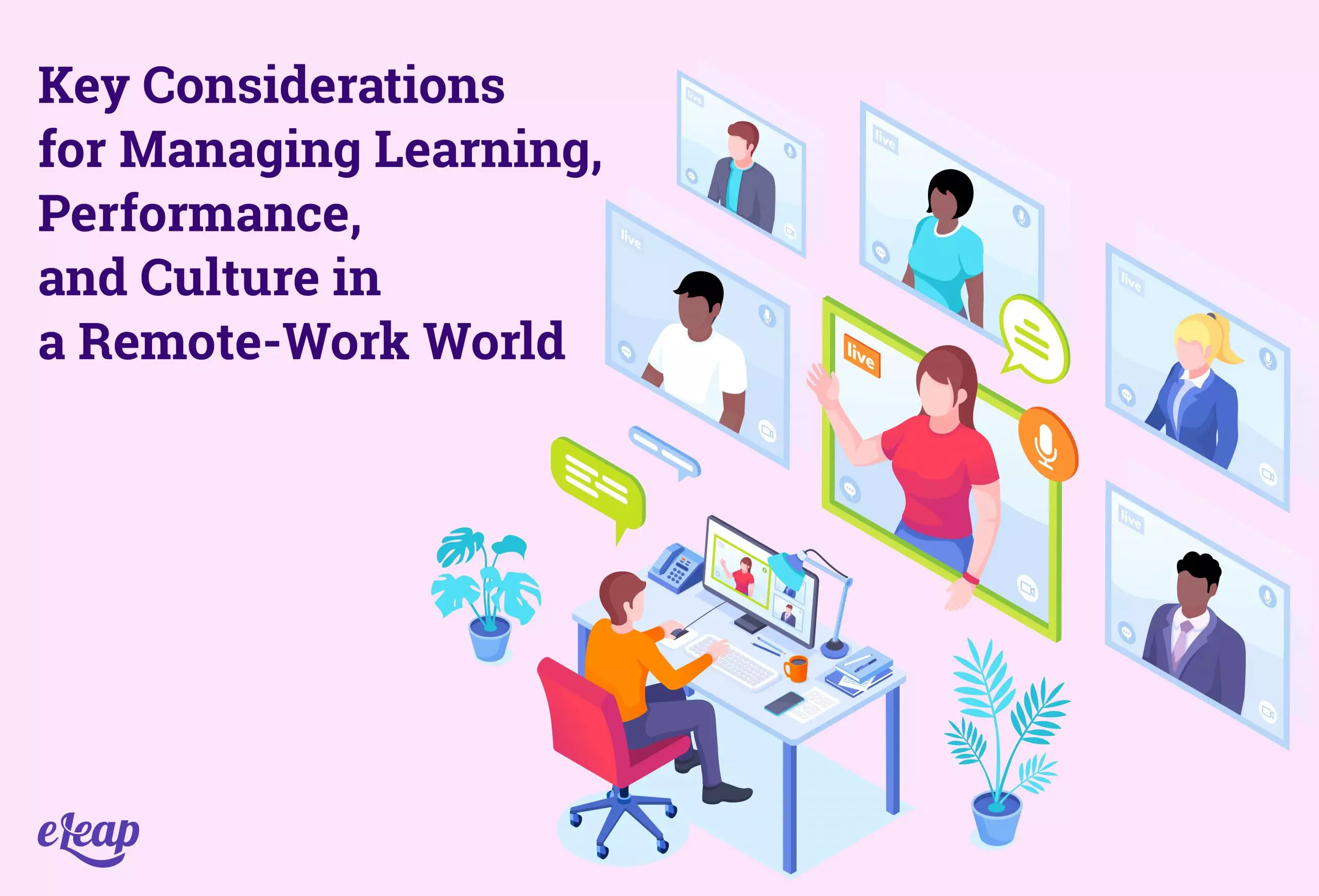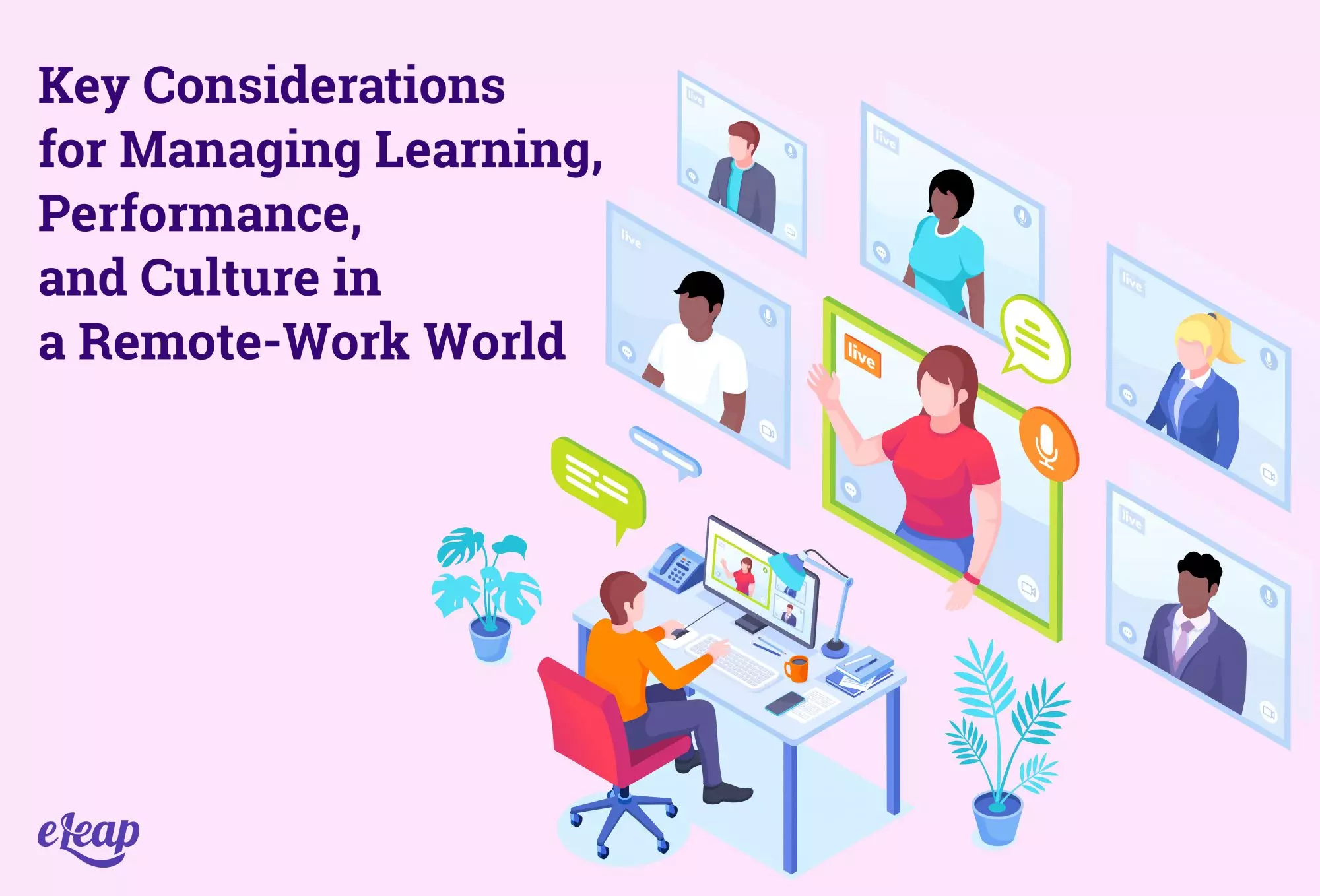Key Considerations for Managing Learning, Performance, and Culture in a Remote-Work World

COVID-19 has greatly accelerated the trend toward remote work. While that trend was present and growing before the pandemic, businesses large and small now find themselves in brand new territory. And for many, at least some elements of remote work will continue long after the pandemic subsides or we find ways to deal with the spread.
There are simply too many benefits (for employers and employees) for things to go back to what we once considered “normal”. With that being said, remote employees present unique challenges when it comes to learning, performance, and culture management. Below, we’ll touch on a few simple, effective ways to simplify that process.

It Really Boils Down to Communication
While there are many, many ways that you can manage learning, performance, and culture, the ability to communicate is central to everything else. Without that ability, nothing else matters. Of course, communication in a remote world creates some pretty unique challenges of its own. Do you communicate by phone? Email? Text message? Something like Slack?
While you’ll discover a horde of communication-focused tools out there, video conferencing options are the best. Why? Well, there are a few reasons, including the following:
- Nonverbal Communication – While we think of ourselves as a species that communicates verbally, that’s not true. Most of our communication is nonverbal, or only lightly tied to verbalizations. For instance, facial expression, body posture, and other nonverbal cues give listeners important insight into what someone is saying, the way it’s being said, and the intent behind the communication.
For example, the same sentence can have more than one meaning depending on whether someone is frowning or smiling. Video conferencing provides the means for each person’s face, head, and shoulders (and often more of their body) to be in the picture, providing more context and clarity for others.
- Connectedness – Sure, text and chat apps can make communication simpler and more streamlined, but there’s an intrinsic disconnect here. Those methods are impersonal. They’re not really human.
Video conferencing, on the other hand, provides a direct, personal connection with the other people on the screen. We can smile when they smile, laugh when they laugh, and focus when they focus. It speaks directly to our nature as social animals and our need to have other people in our lives – our need to be part of a group.
You also need to consider the things that you communicate about amongst the team. Tools like Slack or Trello can provide your team members with the ability to exchange crucial work-related information. However, they can also do so much more. Communication is about more than productivity or learning. It’s about culture and connecting with other human beings in a time when those connections feel like they’re being severed.
Work-Related: In an app like Slack, you can create channels dedicated to specific work-related topics. You might have channels for various teams, channels for L&D related questions and answers, channels for performance-related topics, and more. Plan your communication network so that it supports a diversity of work-related topics, but also provides the means to build and develop your people.
Non-Work Related: In a remote setting, your team members miss out on those non-work-related things that make a workplace worth being in. You don’t get to hear the bad puns, the funny anecdotes, or the personal questions from one employee to another. Make sure that your teams can communicate about non-work-related things so that they can continue feeling like a team.
Some great examples of non-work-related options include the following:
- A virtual company happy hour where employees get together via video chat to have a cold one at the end of the day and enjoy just interacting with one another.
- A pet chat/channel where employees can show off their pets, discuss pet care, etc.
- A show and tell channel where people can show off their latest personal projects, whether that’s sourdough baking, crochet, or something else completely.
Help Set Up Effective Work Spaces
For companies going remote, it’s more important than ever that you provide your team with a helping hand to get their space set up correctly. A few basic guidelines can be found below:
- Set up somewhere quiet, away from the rest of the family, where they can focus on work-related tasks.
- Have two monitors. It’s pretty important for productivity. Some companies are even taking the initiative and providing a second monitor.
- Use surveys and other feedback forms in your LMS to help gauge how well employees are adapting to working remotely and to offer feedback. Anonymizing information can help encourage them to share thoughts freely, too.
Create the Right Environment for Remote Working
Corporate culture will play a significant role in the success (or lack thereof) of your remote work effort. If you can create a corporate culture of compassion and learning, your teams will be better off. You need to be understanding and flexible. People are working from home, which means more interruptions during their day. Dogs and kids may invade video calls. Delivery drivers might interrupt meetings.
Focus on outreach with your teams. Check-in frequently with them. Find out how they’re doing, what they need, and learn how your managers can supply it. Whether that’s more flexibility on deliverables, a shift in responsibilities, or something else, organizations must be more accommodating with a remote situation.
Provide Learning Opportunities
Remote work presents some pretty unique opportunities. One of those is the chance for employees to upskill and develop themselves professionally. Tying your LMS into the remote work system ensures that they can complete courses from home, on their schedule, and build necessary skills.
Note that it’s important that you go forward in a structured way here. Map out group paths for things like mandatory corporate training and professional CE, but don’t neglect voluntary training. Find out what your employees want to achieve and then find ways to make that happen.
Managing learning, development, and productivity in a remote work situation doesn’t have to be an insurmountable challenge. The right steps, a compassionate stance, and the willingness to change and adapt are key.